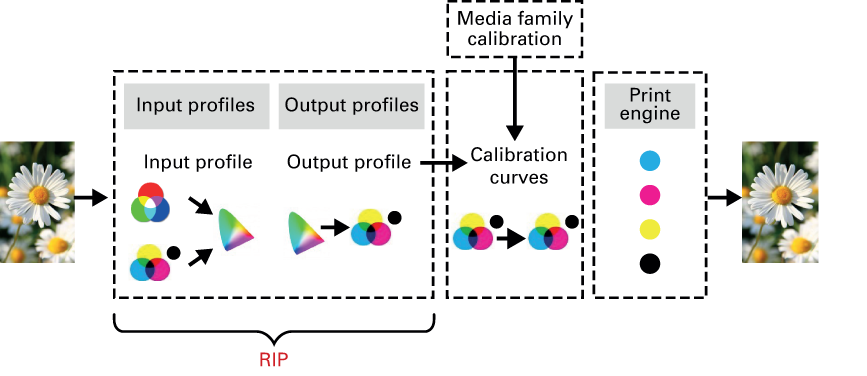

Calibration is very important to keeping the quality of the color reproduction high. The environment of your print system influences the print quality. A constant temperature and humidity are essential for consistent color output.
The print system automatically keeps the print quality as high as possible. However, additional calibration is essential to keep the color reproduction level stable for all media types you use. PRISMAsync Print Server offers an automated and structured workflow and feedback mechanism to integrate calibration into your daily work.
There are two types of calibrations: printer calibration and media family calibration.
It is important to perform the appropriate calibration procedures regularly. You can perform each calibration procedure separately. To ease the process of calibration PRISMAsync Print Server offers an automated procedure. When you perform the Automated color tasks the calibration procedures will be processed automatically in the correct order and with limited operator interaction.
The Automated color tasks can perform:
Auto Gradation Adjustment
Shading correction
Media family calibration
Idealliance® G7® Grayscale test.
There are two procedures, which calibrate the printer:
Automatic gradation adjustment
The automatic gradation adjustment includes precise adjustments of the gradation, density and color quality of the primary colors.
Shading correction
The shading correction includes precise adjustments of slightly uneven color densities in color planes.
There are two modes available for the automatic gradation adjustment:
Standard, for normal media
This recommended mode guarantees a high print quality for most print environments.
Professional, for normal, heavy and extra heavy media
This extended mode is advised when you frequently use heavy and extra heavy uncoated media or when you frequently use coated media.
The printer calibration settings on the control panel show which printer calibration procedures are configured for your print system. The dashboard of the control panel will show the printer calibration indicator
 when printer calibration is required.
when printer calibration is required.
Configuration of printer calibration
If required, consult a color expert to decide what you need to configure for printer calibration to achieve the required color quality:
The standard or professional mode for automatic gradation adjustment.
How often to perform the shading correction.
It is strongly advised to perform the shading correction at least once after the installation of the print system.
It is strongly advised to configure at least the automatic gradation adjustment for daily printer calibration.
You can configure the required printer calibration procedures in the Settings Editor. Then the operator receives a daily reminder to perform the printer calibration.
You define and see the media for the printer calibration in the Settings Editor. You can find it as follows: .
The following media is recommended for printer calibration:
Normal media for standard and professional printer calibration:
Top Colour Zero FSC (100 g/m² / 27 lb bond)
Canon CS-814 (81.4 g/m² / 22 lb bond)
Mondi Neusiedler (100 g/m² / 27 lb bond)
International Paper Hammermill Color Copy Digital (105 g/m² / 28 lb bond)
Heavy media for professional printer calibration:
Top Colour Zero FSC (250 g/m² / 92 lb cover)
Mondi (250 g/m² / 92 lb cover)
Mohawk Navajo Cover 98 bright (243 g/m² / 90 lb cover)
Extra heavy media for professional printer calibration:
Top Colour Zero FSC (300 g/m² / 110 lb cover)
Mondi (300 g/m² / 110 lb cover)
International Paper Hammermill Color Copy Digital (271 g/m² / 100 lb cover)
When the recommended media is not available, you can use custom media for automatic gradation adjustment.
PRISMAsync provides default coated and uncoated media families. A media family is a set of media with the same output profiles (one per halftone) and calibration curves. A media family calibration applies to all media of the media family. You only have to perform a media family calibration for one media of the media family.
Output profiles describe how source colors (in Lab) are mapped to the color space (in CMYK) of the printer. They contain information about the color boundaries a printer can reproduce.

Calibration curves are the result of a media family calibration to ensure that the color quality remains stable over time.
You define the default calibration media for a media family the first time you perform a media family calibration for that media family. Make sure that you use the same calibration media to represent the media family every time you perform a media family calibration.
When media family calibration is completed, the control panel will show the following feedback to inform you how well colors are reproduced:
Comparison with previous calibration
The comparison with the previous calibration shows you how urgently this media family calibration was needed. This feedback helps you to determine how often media family calibration is required.
Measurement of paper white and primary colors
The feedback on the measured paper white and primary colors window shows how close the measured paper white and primary colors approach the reference values. The reference values are taken during the first media family calibration or when you create a new profile with the embedded profiler.
Measurement accuracy in numbers and heatmaps
The measurement accuracy information shows one or more heatmaps that indicate how accurately the patches were measured. PRISMAsync Print Server uses tolerance levels for patch measurements. Based on the configured tolerance levels, heatmap patches turn green, orange-like, or red. The heatmap can indicate a possible problem. When you want to change the tolerance values, contact your Service organization.
You are advised to follow the next calibration scenario to keep the image quality high.
Perform the printer calibration daily.
Perform the shading correction once.
Perform the media family calibration regularly.
Additional procedures are not necessary to keep the print quality high.